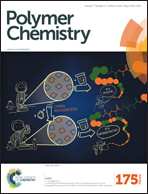Facile synthesis of bowl-shaped nitrogen-doped carbon hollow particles templated by block copolymer “kippah vesicles” for high performance supercapacitors†
Abstract
This paper reports a simple self-assembly strategy towards bowl-shaped carbon-containing hollow particles, as well as an unprecedented potential application for block copolymer vesicles in energy storage. Kippah vesicles (fully collapsed vesicles), formed by solution self-assembly of an amphiphilic polystyrene-block-poly(ethylene oxide) block copolymer, were employed as the template to guide the formation of bowl-shaped nitrogen-doped carbon hollow particles (BNCHPs). As electrode materials of supercapacitors, BNCHPs exhibit superior electrochemical performance. In particular, compared with their spherical counterpart, BNCHPs largely increase their volumetric packing density, leading to much higher volumetric capacitance or volume reduction of electrodes, which is desired for practical supercapacitor devices.


 Please wait while we load your content...
Please wait while we load your content...